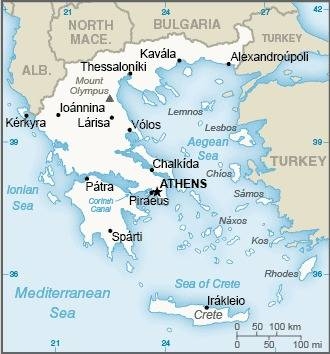80 Greece

Nine equal horizontal stripes of blue alternating with white. A blue square bearing a white cross appears in the upper hoist-side corner. The cross symbolizes Greek Orthodoxy, the established religion of the country. There is no agreed upon meaning for the nine stripes or for the colors.
Flag courtesy of the CIA World Factbook

Map courtesy of the CIA World Factbook

The Parthenon crowns the Acropolis in Athens. The Acropolis is a citadel on a flat, high, rocky outcrop 150 m (490 ft) above sea level and is the highest point in Athens. It preserves a number of ancient structures.
Photo courtesy of the CIA World Factbook
Government
According to Britannica, Greece is a parliamentary republic. The current constitution, introduced in 1975 following the collapse of the 1967–74 military dictatorship, initially gave considerable powers to the president, but revisions to the constitution in 1986 made presidential powers largely ceremonial. The president, who is the head of state, is elected by the unicameral Hellenic Parliament (Vouli) and may serve two five-year terms.
The prime minister is the head of government and has extensive powers but must be able to command the confidence of the legislative branch. The latter, the unicameral Hellenic Parliament, consists of 300 deputies who are elected to four-year terms by direct universal vote; it has the power to revise the constitution. Voting is compulsory. A distinctive feature of the Greek electoral system has been the practice of incumbent governments amending the electoral law to suit their own political advantage. However, another round of constitutional revisions in 2001 introduced safeguards against political abuses, bringing about greater transparency in political operations.
Reorganized administratively in 2011 according to the so-called Kallikratis Plan, Greece is divided into seven apokentroménes dioikíseis (decentralized administrations), the head of each of which is appointed by the central government. These units are further divided into 13 periféreies (regions), which mirror the 13 geographic diamerismata (regions) that existed under the previous administrative structure. At the next level of local government are the 74 perifereiakés enótites (regional units), the administrative and territorial constituents of parts of the regions. Finally, the most local of these administrative unis are the 325 dímoi (municipalities).
The judiciary is essentially the Roman law system prevalent in continental Europe. The two highest courts are the Supreme Court (Areios Pagos), which deals with civil and criminal cases, and the Council of State (Symvoulion Epikrateias), which is responsible for administration disputes. A Court of State Auditors has jurisdiction in a number of financial matters. A Special Supreme Tribunal deals with disputes over the interpretation of the constitution and checks the validity of parliamentary elections and referenda.
Hellenic Civil Aviation Authority
In Greece, the first organized Authority for the Civil Aviation is established in 1926 and in 1929 the Authority of Transporting- Marine Airports is introduced in the MB Admiralty. Though, the first serious organizational effort takes place in 1931 when both L.5017/31 and L.5100/31 “With reference to the Organization of the Civil Aviation Authority” are promulgated. According to the latest law, the authorities beneath are established:
a) The Central Authority, which is consisted of one and only Authority.
b) The Exterior Authority which comprises both the governmental and the Municipal and Communal airports, The Authority of International Aviation Organizations.
During the years 1946-1948, following an attempt of a substantial reformation, a new organizational schema is modulated. The schema in question is called Governmental Civil Aviation Authority and it is structured in the level of General Authority. (Obligatory Law 970/46, Royal decree 615/46, Law decree 634/48) .
In 1952 a Royal Decree transfers the Governmental Civil Aviation Authority from the Ministry of Aviation to the Ministry of Transports at the level of General Division and it is called from this point onwards, Civil Aviation Authority. The above authority operates, based on the above mentioned Royal Decree up to 1960, when the R.D. 865/60 “about the Organization of Civil Aviation Authority” is promulgated. The latest constitutes the most complete Organization from Civil Aviation Authority’ s affiliation with the Ministry of Transports. The Organization in question, defines first the Authority in two organizational levels – the Central Authority and the Regional Services (a structure which is still in force) and second the composition of Organizational Units. Then, with recent organizational efforts, the functional modernization of the Authority is attempted. (Law decree 4195/61, L. 4464/65, D.L. 169/69). Law Decree 714/70, which defines two distinct agents, constitutes an effort to reassure both better flexibility and efficiency. The above agents are the following:
a) the section of Air Transports of the Ministry of Transports, competent in Air Traffic Policy, planning and oversight and
b) Civil Aviation Authority, an independent Public Authority
Hellenic Civil Aviation Authority constitutes, according to the L.D. 714/70, as it is transformed by L. 1340/83, Public Authority of the Ministry for Infrastructure, Transport and Networks. It is under the Minister of Infrastructure, Transport and Networks and it is being administered by the Governor and the Deputy Governor. With Law 2338/95 “Contract for the development of the new International Airport of Athens “Eleftherios Venizelos” at Spata”, the first airport under private management was established, while the rest of the airports remain until today, under State’s control.
Airspace
SkyVector – Google Maps – ADS-B Exchange
ICAO countries publish an Aeronautical Information Publication (AIP). This document is divided into three parts: General (GEN), En Route (ENR) and Aerodromes (AD). ENR 1.4 details the types of airspace classes they chose to adopt from classes A through G.
Hellenic AIP – requires login
National Airspace by the Hellenic Republic
Where you are allowed to fly a UAS in Greece
Drone Regulations
Unmanned Aircraft Systems – Drones
Advanced Air Mobility (AAM) Regulations & Policies
Bilateral agreements facilitate the reciprocal airworthiness certification of civil aeronautical products imported/exported between two signatory countries. A Bilateral Airworthiness Agreement (BAA) or Bilateral Aviation Safety Agreement (BASA) with Implementation Procedures for Airworthiness (IPA) provides for airworthiness technical cooperation between the FAA and its counterpart civil aviation authorities.
Reciprocal acceptance of aviation safety-related approvals and services with the European Union Aviation Safety Agency (EASA) and Member States of the European Union are primarily governed by the U.S. – European Union Safety Agreement.
Advanced Air Mobility (AAM) News
2025
Video courtesy of Advanced Air Mobility Institute from the July 2025 Global AAM Forum.
2025
Video courtesy of Advanced Air Mobility Institute from the January 2025 Global AAM Forum. Complete session for Day 3 of this Forum is available on the Advanced Air Mobility Institute YouTube Channel
2024 – Aria Hotels to construct 4 eVTOL vertiports in Greece
2022 – Hellenic U-space Institute inaugurates first Droneport in South East Europe
Short Essay Questions
Scenario-Based Question
You have been hired by a Drone Startup Company. Your boss has immediately assigned this job to you.
They need you to prepare a one-page memo detailing the legalities of using a drone to film the Acropolis in Athens, pictured above.
They need you to mention any national laws and local ordinances.
They specifically want to know what airspace (insert pictures) you will be operating in and whether or not you need an airspace authorization.
Does it matter whether or not you are a citizen of the country?
Lastly, there is a bonus for you if, as you scroll through this chapter, you find any typos or broken links!
Short Essay Questions
- What are the drone categories?
- How is registration addressed?
- How is remote ID addressed?
- What are the model aircraft rules?
- What are the commercial drone rules?
- Are there waivers or exemptions to the rules? If so, for what?
- Would you share a link to an interactive airspace map?
- How is BVLOS addressed?
- How can you fly drones at night?
- How can you fly drones over people?
- Where do you find drone NOTAMs?
- What are the rules for drone maintenance?
- What are the rules for an SMS program?
- What are some unique rules not mentioned above?
- What are the C-UAS rules?
- What are the AAM rules?

